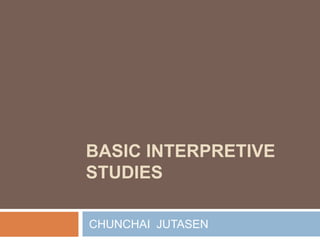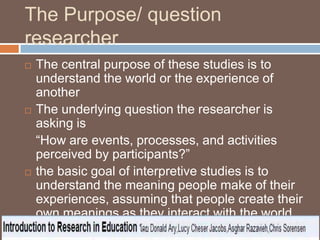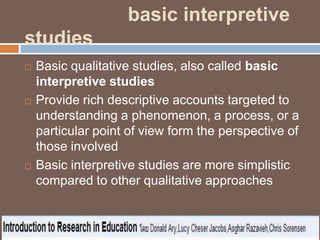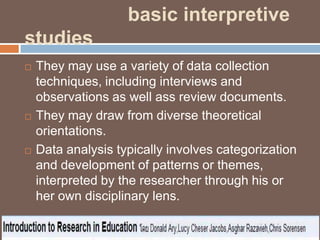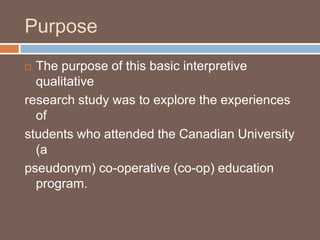Basic interpretive studies
- 1. Basic Interpretive Studies CHUNCHAI JUTASEN
- 2. A basic interpretative studiesāļāļ§āļēāļĄāļŦāļĄāļēāļĒāļāļāļ A basic interpretative studies The Purpose/ question researcherāļĨāļąāļāļĐāļāļ°āļāļāļ A basic interpretative studies āļāļēāļĢāđāļāđāļāļāđāļāļĄāļđāļĨāļāļēāļĢāļ§āļīāđāļāļĢāļēāļ°āļŦāđāļāđāļāļĄāļđāļĨāļāļąāļ§āļāļĒāđāļēāļāļāļēāļāļ§āļīāļāļąāļĒ
- 3. āļāļ§āļēāļĄāļŦāļĄāļēāļĒāļāļīāļĒāļēāļĄ Interpretive Studies āđāļāđāļāļāļēāļĢāļāļĢāļĢāļĒāļēāļĒāļāļēāļĢāļĻāļķāļāļĐāļēāđāļāļīāļāļāļļāļāļ āļēāļ āđāļāļĩāđāļĒāļ§āļāđāļāļāļāļąāļāļāļēāļĢāļāļ āļīāļāļĢāļēāļĒ āđāļāļĒāđāļāđāļāļđāđāļ§āļīāļāļąāļĒāđāļāđāļāļŠāđāļ§āļāļŦāļāļķāđāļāđāļāļŠāļāļēāļāļāļēāļĢāļāđ āļŦāļĢāļ·āļ āđāļāđāļāđāļāļĢāļ·āđāļāļāļĄāļ·āļāđāļāļāļēāļĢāļ§āļīāļāļąāļĒ āđāļāđāļāļēāļĢāļŠāļąāļĄāļ āļēāļĐāļāđ āļāļēāļĢāļŠāļąāļāđāļāļ āđāļĨāļ°āļāļēāļĢāļ§āļīāđāļāļĢāļēāļ°āļŦāđāđāļāļāļŠāļēāļĢāđāļāļāļēāļĢāļ§āļīāđāļāļĢāļēāļ°āļŦāđāļāđāļāļĄāļđāļĨāđāļĨāđāļ§āļāļģāļĄāļēāļāļąāļāļāļĨāļļāđāļĄ āđāļāļĒāļāļąāļāļāđāļāļĄāļđāļĨāļāļĩāđāđāļĄāđāļāļĢāļāļāļąāļāļāļāļāđāļ (Merriam B. Sharan, The Nature of Qualitative Inquiry,2002 : 6-7 )Interpretive Studies āđāļāđāļāļāļēāļĢāļŠāļĢāđāļēāļāļāļ§āļēāļĄāđāļāđāļēāđāļāļāļĢāļēāļāļāļāļēāļĢāļāđāļāļĢāļĢāļĄāļāļēāļāļī āđāļāļĒāļāđāļēāļāļāļĢāļ°āļāļ§āļāļāļēāļĢ āļāļēāļĢāļĄāļĩāļŠāđāļ§āļāļĢāđāļ§āļĄāļāļāļāļāļđāđāļ§āļīāļāļąāļĒ (Orlikowski and Baroudi, 1991)Interpretive āđāļāđāļāļ§āļīāļāļĩāļāļēāļĢāļāļĩāļāļ§āļēāļĄāļŦāļĄāļēāļĒāļāļāļāļāļēāļāļ§āļīāļāļąāļĒāļāļēāļāļāļ§āļēāļĄāļĢāļđāđāļāļāļāļāļđāđāļ§āļīāļāļąāļĒ āđāļāļĒāđāļāđāļāļēāļĢāļāļĢāļ°āļāļģāļāļāļāļĄāļāļļāļĐāļĒāđāđāļāđāļāļŦāļĨāļąāļ (Walsham. 1993)
- 4. āļāļ§āļēāļĄāļŦāļĄāļēāļĒA basic interpretative studies provides descriptive accounts targeted to understanding a phenomenon using data that might be collected in a variety of ways, such as interviews, observations, and document review. The purpose in to understand the world or experience of another. These are the most simple and most common qualitative studies. (Donald Ary, Lucy Cheser Jacobs, AsgharRazavieh, Chris Sorensen, 2009 : P453)
- 5. The Purpose/ question researcherThe central purpose of these studies is to understand the world or the experience of anotherThe underlying question the researcher is asking is âHow are events, processes, and activities perceived by participants?âthe basic goal of interpretive studies is to understand the meaning people make of their experiences, assuming that people create their own meanings as they interact with the world around them.
- 6. āļĨāļąāļāļĐāļāļ°āļāļāļ basic interpretive studiesBasic qualitative studies, also called basic interpretive studiesProvide rich descriptive accounts targeted to understanding a phenomenon, a process, or a particular point of view form the perspective of those involvedBasic interpretive studies are more simplistic compared to other qualitative approaches
- 7. āļĨāļąāļāļĐāļāļ°āļāļāļ basic interpretive studiesThey are not restricted to a particular phenomenon as in case studies.They do not seek to explain sociocultural aspects as in ethnographyThey do not seek to enter the subjectâs conceptual world to explain the âessenceâ as in phenomenology.
- 8. āļĨāļąāļāļĐāļāļ°āļāļāļ basic interpretive studiesThey do not seek to define theory as in grounded theory research.They do not convey life stories through narrative analysis, delve into history, or focus on analyzing content.
- 9. āļĨāļąāļāļĐāļāļ°āļāļāļ basic interpretive studiesThese studies are, as the name implies, basic. They describe and attempt to interpret experience.These studies are the most common qualitative studies and are used in a variety of disciplines, including education.
- 10. āļĨāļąāļāļĐāļāļ°āļāļāļ basic interpretive studiesThey may use a variety of data collection techniques, including interviews and observations as well ass review documents.They may draw from diverse theoretical orientations. Data analysis typically involves categorization and development of patterns or themes, interpreted by the researcher through his or her own disciplinary lens.
- 11. āļĨāļąāļāļĐāļāļ°āļāļāļ basic interpretive studiesOften, these studies may be shorter in duration than some of the other qualitative forms, with the researcher not as fully involved in the context.
- 12. āļāļēāļĢāđāļāđāļāļāđāļāļĄāļđāļĨāđāļĨāļ°āļ§āļīāđāļāļĢāļēāļ°āļŦāđāļāđāļāļĄāļđāļĨMany beginning qualitative researchers conduct basic interpretive studies. Such questions as âHow did teachers feel about the new curriculumâ or âWhat instructional strategies do students think are engaging and whyâ might be answered in a basic qualitative study using interviewing or focus group techniques, these basic studies may use a variety of techniques for collecting data, such as such as interviews, observations, and document review. Analysis focused on identifying recurrent themes or patterns.
- 13. āļāļąāļ§āļāļĒāđāļēāļāļāļēāļĢāļ§āļīāļāļąāļĒFor Example, a researcher might interviewing students at various high school grade levels about their experiences in the classroom to try and understand their perceptions on instructional techniques. By searching of themes and patterns on the data. The researcher could attempt to answer the question about which strategies appear to engage the students. Or the researcher could Videotape or conduct in-person observations of high school classrooms to answer this question.
- 14. āļāļąāļ§āļāļĒāđāļēāļāļāļēāļāļ§āļīāļāļąāļĒāļāļ·āđāļāđāļĢāļ·āđāļāļ Connected Learning in Co-operative Educationāļāļ·āđāļāđāļĢāļ·āđāļāļāļāļđāđāļ§āļīāļāļąāļĒ Jeela Jones University of Ottawa āļāļĩ 2007
- 15. The research sub-questions include1. How do co-operative education students behave as connected learners?2. What do co-operative education student experiences reveal about co-operative education?
- 16. PurposeThe purpose of this basic interpretive qualitativeresearch study was to explore the experiences ofstudents who attended the Canadian University (apseudonym) co-operative (co-op) education program.
- 17. MethodTo explore participantâs experiences within the Cooperative Education Programs at Canadian University , the basic interpretive qualitative research design and associated data collection method of interviewing were employed.The basic interpretive method also guided the data analysis process to focus on gaining an understanding of the data through the voices of the participants.
- 18. Participants and SiteParticipants for this research study were selected through the use of the co-op programsâ main database.There were 279 students who graduated in December 2004 and possibly available for participation in this study.
- 19. Data CollectionThree students per degree program were selected for a total of 15 students.The three from each degree â which included administration, arts, engineering, science, and social science - were selected based on the following criteria: (a) graduated in the previous term from theCanadian University; (b) completed all required co-opwork terms; and (c) maintained a local address andphone number.
- 20. Data CollectionThe identity of each participant was masked through the use of pseudonyms. Following the basic interpretive design, open-ended questions were used. The questions asked participants to describe their experience with the co-operative education programs and what it means to them
- 21. Data CollectionEach interview was digitally recorded and latertranscribed verbatim. Participantsâ transcriptions werereturned to them via e-mail in order that they couldverify the accuracy of the data collected.
- 22. Data Analysisdata was recorded and then transcribed.the interview data was reviewed, first to gain a general understanding of the meaning and then more thoroughly to develop open codesFinally, interpretation occurred by comparing themes and showcasing how they interrelate the themes and patterns were compared to the field notes to check between first impressions and what became apparent through the transcribed words.
- 23. Trustworthiness, or validity,Trustworthiness was achieved in three key ways: (a) careful triangulation between the interviews, the interview transcriptions, and field notes;(b) member checking by participants of the interview transcriptions, themes, and descriptions; and (c) rich, thick description of the participantsâ experiences in the final report.
- 24. ConclusionFindings for this study were examined through the lens of connected-learning, a learning method that places emphasis on discussion, collaboration, and acceptance for knowledge development. Several themes emerged including experience, relationships, time, fees, and luck. Findings suggest that co-operative education is beneficial.

